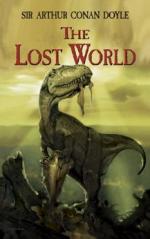“From the contents of the knapsack it was evident that this man had been an artist and poet in search of effects. There were scraps of verse. I do not profess to be a judge of such things, but they appeared to me to be singularly wanting in merit. There were also some rather commonplace pictures of river scenery, a paint-box, a box of colored chalks, some brushes, that curved bone which lies upon my inkstand, a volume of Baxter’s `Moths and Butterflies,’ a cheap revolver, and a few cartridges. Of personal equipment he either had none or he had lost it in his journey. Such were the total effects of this strange American Bohemian.
“I was turning away from him when I observed that something projected from the front of his ragged jacket. It was this sketch-book, which was as dilapidated then as you see it now. Indeed, I can assure you that a first folio of Shakespeare could not be treated with greater reverence than this relic has been since it came into my possession. I hand it to you now, and I ask you to take it page by page and to examine the contents.”
He helped himself to a cigar and leaned back with a fiercely critical pair of eyes, taking note of the effect which this document would produce.
I had opened the volume with some expectation of a revelation, though of what nature I could not imagine. The first page was disappointing, however, as it contained nothing but the picture of a very fat man in a pea-jacket, with the legend, “Jimmy Colver on the Mail-boat,” written beneath it. There followed several pages which were filled with small sketches of Indians and their ways. Then came a picture of a cheerful and corpulent ecclesiastic in a shovel hat, sitting opposite a very thin European, and the inscription: “Lunch with Fra Cristofero at Rosario.” Studies of women and babies accounted for several more pages, and then there was an unbroken series of animal drawings with such explanations as “Manatee upon Sandbank,” “Turtles and Their Eggs,” “Black Ajouti under a Miriti Palm”—the matter disclosing some sort of pig-like animal; and finally came a double page of studies of long-snouted and very unpleasant saurians. I could make nothing of it, and said so to the Professor.
“Surely these are only crocodiles?”
“Alligators! Alligators! There is hardly such a thing as a true crocodile in South America. The distinction between them——”
“I meant that I could see nothing unusual—nothing to justify what you have said.”
He smiled serenely.
“Try the next page,” said he.
I was still unable to sympathize. It was a full-page sketch of a landscape roughly tinted in color—the kind of painting which an open-air artist takes as a guide to a future more elaborate effort. There was a pale-green foreground of feathery vegetation, which sloped upwards and ended in a line of cliffs dark red in color, and curiously ribbed like some basaltic formations which I have seen. They extended in an unbroken wall right across the background. At one point was an isolated pyramidal rock, crowned by a great tree, which appeared to be separated by a cleft from the main crag. Behind it all, a blue tropical sky. A thin green line of vegetation fringed the summit of the ruddy cliff.




